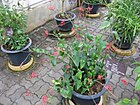Note: This is a project under development. The articles on this wiki are just being initiated and broadly incomplete. You can Help creating new pages.
Plumbago indica
Indian leadwort is an evergreen perennial herb. It grows up to 1.5 metres tall. The plant is often grown in the backyard for personal use, It is cultivated for medicinal use in India and is also grown as an ornamental in various parts of the tropics, where it is valued for its white inflorescences.
Contents
[hide]- 1 Uses
- 2 Parts Used
- 3 Chemical Composition
- 4 Common names
- 5 Properties
- 6 Habit
- 7 Identification
- 8 List of Ayurvedic medicine in which the herb is used
- 9 Where to get the saplings
- 10 Mode of Propagation
- 11 How to plant/cultivate
- 12 Commonly seen growing in areas
- 13 Photo Gallery
- 14 References
- 15 External Links
Uses
Leprosy, Rheumatism, Paralysis, Tumours, Headaches, Toothache, Haemorrhoids, Swollen glands, Indigestion.[1]
Parts Used
Chemical Composition
It contains nine compounds were isolated as plumbagin, isoshinanolone, plumbagic acid, beta-sitosterol, 4-hydroxybenzaldehyde, trans-cinnamic acid, vanillic acid, 2, 5-dimethyl-7-hydroxychromonede, indole-3-carboxaldehyde.[2]
Common names
| Language | Common name |
|---|---|
| Kannada | ಚಿತ್ರಮಲಿಕಾ Chitramulika |
| Hindi | Lal chitrak |
| Malayalam | Kotuveli |
| Tamil | Akkini |
| Telugu | |
| Marathi | |
| Gujarathi | Kalochitrak |
| Punjabi | |
| Kashmiri | |
| Sanskrit | |
| English | Plumbago, Scarlet leadwort |
Properties
Reference: Dravya - Substance, Rasa - Taste, Guna - Qualities, Veerya - Potency, Vipaka - Post-digesion effect, Karma - Pharmacological activity, Prabhava - Therepeutics.
Dravya
Rasa
Guna
Veerya
Vipaka
Karma
Prabhava
Habit
Identification
Leaf
| Kind | Shape | Feature |
|---|---|---|
Flower
| Type | Size | Color and composition | Stamen | More information |
|---|---|---|---|---|
| {{{5}}} |
Fruit
| Type | Size | Mass | Appearance | Seeds | More information |
|---|---|---|---|---|---|
Other features
List of Ayurvedic medicine in which the herb is used
Where to get the saplings
Mode of Propagation
Stem cuttings, Root cuttings, Seeds.
How to plant/cultivate
A plant of tropical areas, it thrives very well at temperatures of 25 - 35°c.[5]
Commonly seen growing in areas
Locally semi-spontaneous, Often persistent, Teak forest.
Photo Gallery
References
- Jump up ↑ Indian Medicinal Plants by C.P.Khare
- Jump up ↑ Chemical constituents
- Jump up ↑ Common names
- Jump up ↑ [Morphology]
- Jump up ↑ Cultivation
External Links
- Ayurvedic Herbs known to be helpful to treat Leprosy
- Ayurvedic Herbs known to be helpful to treat Rheumatism
- Ayurvedic Herbs known to be helpful to treat Paralysis
- Ayurvedic Herbs known to be helpful to treat Tumours
- Ayurvedic Herbs known to be helpful to treat Headaches
- Ayurvedic Herbs known to be helpful to treat Toothache
- Ayurvedic Herbs known to be helpful to treat Haemorrhoids
- Ayurvedic Herbs known to be helpful to treat Swollen glands
- Ayurvedic Herbs known to be helpful to treat Indigestion
- Herbs with Leaves used in medicine
- Herbs with Roots used in medicine
- Herbs with common name in Kannada
- Herbs with common name in Hindi
- Herbs with common name in Malayalam
- Herbs with common name in Tamil
- Herbs with common name in Gujarathi
- Herbs with common name in English
- Habit - Evergreen shrub
- Index of Plants which can be propagated by Stem cuttings
- Index of Plants which can be propagated by Root cuttings
- Index of Plants which can be propagated by Seeds
- Herbs that are commonly seen in the region of Locally semi-spontaneous
- Herbs that are commonly seen in the region of Often persistent
- Herbs that are commonly seen in the region of Teak forest
- Herbs
- Pages without herbs images




